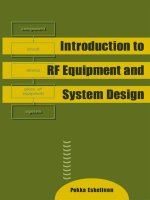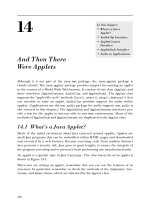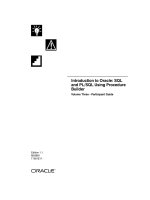Introduction to RF Equipment and System Design
Bạn đang xem bản rút gọn của tài liệu. Xem và tải ngay bản đầy đủ của tài liệu tại đây (3.08 MB, 281 trang )
Introduction to RF Equipment
and System Design
For a listing of recent titles in the Artech House
Radar Library, turn to the back of this book.
Introduction to RF Equipment
and System Design
Pekka Eskelinen
Artech House, Inc.
Boston • London
www.artechhouse.com
Library of Congress Cataloging-in-Publication Data
A catalog record of this book is available from the U.S. Library of Congress.
British Library Cataloguing in Publication Data
Eskelinen, Pekka
Introduction to RF equipment and system design.—(Artech House radar library)
1. Radio—Equipment and supplies 2. Wireless communications systems—Design and con
-
struction 3. Radio frequency
I. Title
621.3’84
ISBN 1-58053-665-4
Cover design by Igor Valdman
© 2004 ARTECH HOUSE, INC.
685 Canton Street
Norwood, MA 02062
All rights reserved. Printed and bound in the United States of America. No part of this book
may be reproduced or utilized in any form or by any means, electronic or mechanical, includ
-
ing photocopying, recording, or by any information storage and retrieval system, without
permission in writing from the publisher.
All terms mentioned in this book that are known to be trademarks or service marks have
been appropriately capitalized. Artech House cannot attest to the accuracy of this informa
-
tion. Use of a term in this book should not be regarded as affecting the validity of any trade
-
mark or service mark.
International Standard Book Number: 1-58053-665-4
10987654321
.
Contents
Preface ix
Acknowledgments xi
CHAPTER 1
Introduction 1
1.1 Definitions 1
1.2 What the Reader Should Already Know 3
1.3 Style of Approach 5
1.4 Goals in System Design 7
1.5 The Spirit of System Design 7
1.6 Reliability and Availability 9
1.7 Effects of User Profile 10
1.8 Project Working 11
References 12
CHAPTER 2
Available Parameters 15
2.1 Standardization and Regulations 15
2.2 Frequency 16
2.3 Power 22
2.4 NF 24
2.5 RF Transmission Lines 25
2.6 Geographical Topology 28
2.7 Modulation 29
2.8 Effects of the Baseband Signal 31
2.9 Signal Processing 32
2.10 Nonelectrical Factors 33
References 36
CHAPTER 3
Systems Problems Involving Wave-Propagation Mechanisms 37
3.1 Propagation Models in Brief with Reference to System Design 38
3.2 Means to Counter Adverse Conditions (Stationary and Nonstationary) 42
3.2.1 Attenuation 42
vii
3.2.2 Scattering 46
3.2.3 Multipath Problems 48
3.2.4 Interference Issues 51
3.3 Examples 51
3.3.1 Unexpected Ionospheric Disturbances at HFs 51
3.3.2 Interference Problems in Microwave Links 54
3.3.3 Reception of Weak Geostationary Satellite Signals 59
References 60
CHAPTER 4
Circuits and Components for System Evaluations and Design 63
4.1 Standard or Custom Design? 63
4.2 Passive Modules 64
4.2.1 Terminations 64
4.2.2 Attenuators 65
4.2.3 Power Dividers and Combiners 66
4.2.4 Filters 66
4.2.5 Directional Couplers 70
4.2.6 Isolators 71
4.3 Active Modules 71
4.3.1 Detectors 72
4.3.2 Switches 74
4.3.3 Mixers 76
4.3.4 Amplifiers 79
4.3.5 Oscillators 83
4.3.6 Modulators and Demodulators 87
4.3.7 Upconverters/Downconverters 90
4.3.8 Power Supplies 90
4.4 Mechanics 91
4.5 Purchasing Modules for Equipment Development 93
References 94
CHAPTER 5
Antennas and Associated Hardware 97
5.1 Antenna Selection Criteria 98
5.2 Some Antenna Types 103
5.2.1 Individual Antenna Elements 104
5.2.2 Antenna Arrays 113
5.2.3 Vehicle-Mounted Arrays 128
5.3 Antennas as Mechanical Elements 134
5.3.1 Antenna Mounting on Test Vehicles 134
5.3.2 A Tracking System for a 3-m Reflector Antenna 137
5.4 RF Transmission Lines 140
5.4.1 Coaxial Cables 141
5.4.2 Waveguides 146
5.5 Connectors 147
5.5.1 General Performance Requirements 148
viii Contents
5.5.2 Fundamental Construction 148
5.5.3 Common RF Connector Types for Mechanical Modules 149
5.5.4 Connectors as Components in Milled or Sheet Assemblies 152
5.6 Rotary Joints and Flexible Waveguides 153
5.6.1 Rotary Joints 154
5.6.2 Flexible Waveguides 155
References 157
CHAPTER 6
TXs, RXs, and Transceivers 159
6.1 Requirements for TX 160
6.2 Block Diagram 166
6.3 Choosing the Building Blocks 168
6.4 Requirements for RXs 170
6.5 Block Diagram 174
6.6 Choosing the Building Blocks 176
6.7 Selecting an RX for the System 179
6.8 Transceiver Specialties 180
6.9 Examples 183
6.9.1 Satellite System Ground Beacon 183
6.9.2 Material Analysis with Millimeter Waves 188
6.9.3 Mobile Millimeter-Wave Radar 193
6.9.4 Microwave Telemetry System 198
6.9.5 UHF Time and Frequency Reference 203
References 212
CHAPTER 7
RF Measuring Instrumentation 215
7.1 Defining a Test Setup 215
7.2 Typical Test Instruments for Systems 217
7.3 Ready-Made or Tailored 218
7.4 About Computer Control 219
7.5 Examples 220
7.5.1 Estimating VHF Ground Conductivity 221
7.5.2 High-Power HF VNA 225
7.5.3 Pattern and Impedance Measurements of Compact Antennas 226
7.5.4 Test Instrumentation for Air Navigation Facilities 229
References 241
List of Acronyms 243
List of Symbols 249
About the Author 253
Index 255
Contents ix









